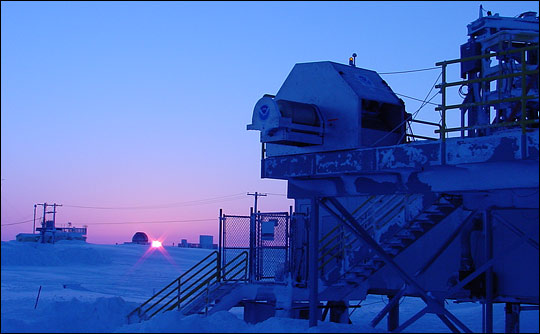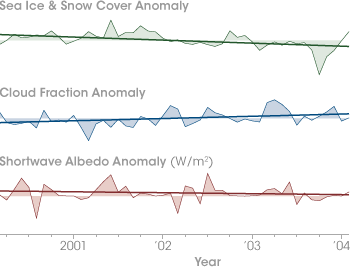

Sea Ice and Snow Change, but Reflection Remains the Same | |||
Among the first things the data revealed was a definite seasonal difference in cloudiness over the polar regions. Cloud fraction (the fraction of the area in a map’s grid box covered by cloud) over the Arctic was about 0.5 in the winter and 0.8 in the summer. Over the Antarctic, the seasonal difference was more subtle. Even though the cloud fraction over ocean areas increased from 0.7 to 0.9 between winter and summer, the cloud fraction over land decreased from 0.65 to 0.45. For the Antarctic as a whole, the changes essentially cancelled each other out. To confirm their findings in the Arctic, the team compared the satellite results to ground-based observations made by radars and lidars in a remote field station in Barrow, Alaska. (Lidar is like radar except it uses laser pulses instead of microwaves.) They found a good match. |
|||
 | |||
Being able to establish a definite seasonal cycle in polar clouds during this period would have been an important contribution to climate change research all on its own. But the results only got more interesting. Although sea ice and snow cover had noticeably declined in the Arctic from 2000 to 2004, there had been no detectable change in the albedo measured at the top of the atmosphere: the proportion of light the Arctic reflected hadn’t changed. In other words, the ice albedo feedback that most climate models predict will ultimately amplify global warming apparently hadn’t yet kicked in. Kato quickly understood why: not only is the Arctic’s average cloud fraction on summer days large enough—on average 0.8, or 80 percent—to mask sea ice changes, but an increase in cloudiness between 2000 and 2004 further hid any impact that sea ice and snow losses might have had on the Arctic’s ability to reflect incoming light. According to the MODIS observations, cloud fraction had increased at a rate of 0.65 percent per year between 2000 and 2004. If the trend continues, it will amount to a relative increase of about 6.5 percent per decade. At least during this short time period, says Kato, increased cloudiness in the Arctic appears to have offset the expected decline in albedo from melting sea ice and snow. |
To verify the trends in Arctic cloudiness that they detected with satellite data, Kato and his team compared their results to observations of clouds collected at a research site in Barrow, Alaska. (Photograph courtesy U.S. Department of Energy’s Atmospheric Radiation Measurement Program.) | ||
 |

Being able to demonstrate these effects from such a short span of data was a bit of surprise, admits Kato. “If I have a hundred ideas,” he says with a laugh, “maybe one percent turn out to be good ones. You have to try to let measurements speak for themselves, but it can be very frustrating at times, when intuitively you think your ideas must be right, but because of measurement errors, or other problems, you can’t prove it. Normally, four years of data would not be enough, but with this one,” he jokes, “maybe we just got lucky.” Bruce Wielicki, lead scientist for the CERES instruments, helps to put these results in context. The response of clouds to global warming—or any other climate change—is one of the biggest sources of uncertainty in climate predictions. Those uncertainties are why studies like this one are so important, says Weilicki. “These results give modelers an opportunity to test their cloud feedbacks against something specific.” Clouds are chameleon-like characters. Whether clouds will aggravate or ameliorate global warming depends on an almost bewildering array of factors: cloud fraction, altitude, type, latitude, season, to name a few. They can reflect incoming sunlight, lessening global warming. They can also absorb energy radiated from the Earth’s surface, and, in turn, emit more energy back toward the surface than greenhouse gases. In the Arctic, scientists suspect that clouds’ energy-absorbing and emitting effects outweigh their sun-shielding effects, making their overall feedback on the surface a warming one. This question of Arctic clouds’ overall influence on the energy balance is the next idea that has gripped Kato’s scientific curiosity. In addition to extending his analysis as a longer time series of data becomes available from Terra and Aqua, Kato plans to investigate whether CERES has detected any changes in the amount of radiation the Earth emitted over the Arctic during this period. The question of what he will do next prompts Kato to return to the topic of curiosity, and what creates his intense interest in “seeing what’s around the corner.” Partly, the reason is wrapped up in his answer to another question: do you personally feel scared or worried about global warming? “Before I started studying this, I would say, yes, I did feel a little worried.” Now that he is learning about the problem, he says, he feels less worried, though not because his studies have led him to believe global warming isn’t real. It’s just that there is a satisfaction, a relief, in knowing that he is doing something to address the problem. “I’m not making policy or developing an efficient car,” he says, “but I am helping us better understand the problem.” For Kato, there is another, simpler, source of satisfaction: the pleasure of knowing things about how nature works. “I guess I would say that it’s like if you go to a museum,” he says. “If you know something about history, you’re probably going to enjoy the things you see more. I feel that way about nature. The more I know about nature, the more enjoyable life is.”
The author would like to thank Claire Parkinson and Bruce Weilicki for providing background information and reviewing this article. |
Comparisons of anomalies (differences from average) of sea ice and snow (top, green), cloud fraction (middle, blue), and albedo (bottom, red) from 2000–2004 show that while sea ice and snow cover in the Arctic went down, cloudiness went up. The general cloudiness of the Arctic combined with the overall increase in cloudiness canceled out the influence of declining sea ice and snow, leaving the amount of sunlight reflected by the Arctic unchanged. (Graphs adapted by Robert Simmon from Kato et. al., 2006.) | |